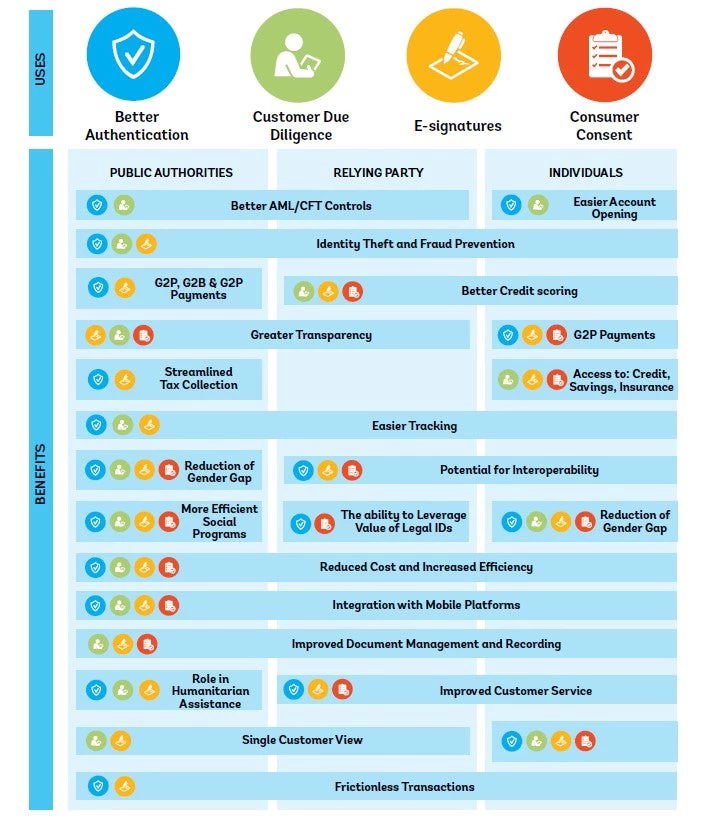The World Bank estimates that roughly one billion people lack an official foundational identification. These one billion people are unable to prove their identity (ID), and millions more have forms of identification that cannot be reliably verified or authenticated, resulting in exclusion from economic opportunities – such as those being created by the emerging digital economy – as well as social and political rights.
The World Bank’s 2017 Global Findex Survey found that the lack of documentation was a critical barrier to accessing financial services, cited by 26 percent of unbanked people in low-income countries. A barrier more pronounced in marginalized segments of society such as women, poor rural farmers, migrants, refugees and stateless persons. The survey found that the poorest 40 percent of women in low income countries are, on average, about 30 percent less likely to have an ID than men in the same wealth quintiles.
Under the Global Partnership for Financial Inclusion (GPFI) of the Argentine G20 Presidency in 2018 and the Identification for Development (ID4D) Initiative, the World Bank published a G20 Digital Identity Onboarding report, where we highlight the three characteristics crucial to enable usage of ID for financial services: the ID should a) have a legal basis and hence be recognized by the government, b) be unique to that individual and c) exist in a digital format. It needs to be noted that there are several other implicit aspects that are essential, notably that the ID should be accurate, secure, privacy-preserving and, for foundational IDs, have universal accessibility.

The diagram above emphasizes that the absence of a legally-recognized ID impacts all access to basic financial services, a lack of unique ID obscures a reliable view of customer activity and can impact access to the full range of financial services; and the lack of a unique digital ID increases the costs of providing financial services to certain segments of society, thereby impacting financial inclusion.
A reliable ID is integral to providing and obtaining financial services because it is needed at various stages in an individual’s interaction with the formal financial sector. During account opening, a customer needs identity credentials so that the financial service provider (FSP) can match that information against other sources, such as a national population registry, civil registry or a credit bureau hence reliably validating that individual. Once validated, a transaction identifier, such as a Personal Identification Number (PIN) is issued by the FSP to allow a customer to continue carrying out financial transactions without the need for re-validation for each transaction.
ID systems that provide digital authentication services can help service providers carry out Customer Due Diligence (CDD) requirements and expand the use of financial services. For example, India’s Aadhaar system enables agents equipped with point of sale devices to satisfy CDD regulations for bank accounts opening nearly-instantaneously by using just the Aadhaar number and authentication factor (e.g. a fingerprint or One Time Password by SMS). One of the key components of financial inclusion strategies in many countries is to introduce a basic account—offered by either banks or non-bank entities—with stringent limits on number of transactions and value of transactions. The objective behind the limitations is to prevent identity theft, financial fraud, money laundering and terrorist financing, while at the same time enabling access to transaction accounts. Inclusive digital ID systems address the lack of documentation to access financial services. It can provide an efficient means of meeting CDD needs, potentially leading to some limitations being lifted over time due to a better understanding of a customer’s profile.
In our G20 Digital Identity Onboarding report, we identified seven policy considerations relevant to digital ID for the financial sector. These align with the 10 Principles on Identification for Sustainable Development – endorsed by 25 organizations to date – which outline what a ‘good’ ID system looks like. The considerations address factors including the importance of integrated ID frameworks; appropriate regulatory frameworks; risk-mitigating oversight models considering new players beyond traditionally regulated financial institutions; authentication and personal data protection; procedures for redress when the security of personal data is comprised; empowering the private sector to develop services drawing the foundational ID infrastructure; and the close monitoring of emerging trends in ID, such new models (e.g. federated and decentralized ID). The Financial Inclusion Global Initiative’s (FIGI) working group, funded by the Bill and Melinda Gates Foundation, on digital ID is working to translate these policy considerations into practical approaches that can be applied at the national level given different country contexts and regulatory frameworks that pertain to the financial sector.

The diagram above illustrates the wide range of applications of digital ID within the formal financial sector, from account opening and meeting CDD requirements to identity authentication as an individual continues to carry out financial transactions. In addition, digital ID holds the potential to transform payment services offered by FSPs and improve delivery of government-to-person (G2P) payments. Digital ID also impacts the effectiveness of credit reporting systems and facilitates digital signatures and insurance schemes.
Digital IDs however, come with risks which need to be managed and mitigated to build trust and harness the benefits of identification responsibly. Detail on the risks including issues of data - leakage, storage and misuse, untested technologies and risks from players outside the traditional financial system will be the topic of a separate blog. An important mitigation factor – apart from strong laws and regulations – is incorporating data protection and privacy in the design of digital ID systems.
Expanding the coverage of ID systems is a specific target of the UN Sustainable Development Goals (SDGs), calling for UN Member States to “provide legal identity for all, including birth registration” by 2030. The World Bank Group’s ID4D Initiative plays a leading role in global and country efforts to realize the transformational potential of digital ID. Digital ID has the potential to further the financial inclusion agenda by: a) making it easier for the unbanked to open a transaction account in conjunction with simplifying documentation requirements, b) enabling more cost-effective customer onboarding that can be conducted remotely and c) contributing to financial sector by supporting the delivery of additional services to the individual such as digital signatures and obtaining customer consent.



Join the Conversation